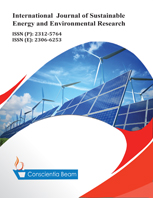Daily and spatial generation of palm oil mill effluent in determining volumetric capacity for bio-methane planning
DOI:
https://doi.org/10.18488/13.v13i2.3772Abstract
Cumulative determination of wastes generated per day and in different periods is a necessary prerequisite for planning waste recovery and averting environmental degradation. This study examined palm oil mills (small, medium and large-scaled mills) in the oil palm (Elaeis guineensis) industry at Ohaji/Egbema Local Government Area (LGA), Imo State, Nigeria for daily and periodic generation of palm oil mill effluent (POME). Survey research design was used. Eight catchment communities of the large-scaled mill, Agricultural Development Authority Palm (ADAPALM) were categorised into three strata in relation to the number of small-scaled mills in each community. In each stratum, a community was randomly sampled. Nine small-scaled mills were sampled from the three communities using proportional sampling. The lone medium and large-scaled mill in the study area represented the other scales of milling. For small and medium-scaled mills, the volume of POME generated was measured from the dimensions of the vessels where POME was stored, while that of large-scaled mill was obtained from industrial records. Independent sample T-test revealed an average of 17.574±0.408m3 POME/day and 15.509±0.465m3 POME/day in wet and the dry seasons respectively (p˂0.01). Similarly, within milling-scales, ANOVA and T-test showed that significant variations occur (p<0.01). Wilcoxon’s test revealed that there was no significant difference (p˃0.05) in the median functional small-scaled mills across seasons, hence functionality did do not influence the volume of POME generated across seasons. The findings revealed the copious volume of POME generated in the area and the required volumetric requirements to planning its collection and transformation to wealth.

